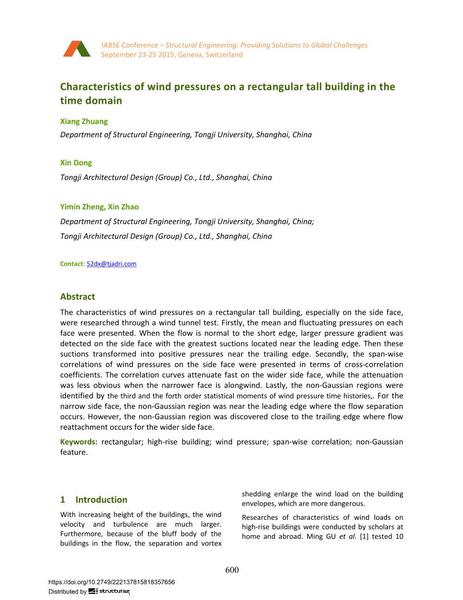Characteristics of wind pressures on a rectangular tall building in the time domain

|
|
|||||||||||
Bibliographic Details
| Author(s): |
Xiang Zhuang
(Department of Structural Engineering, Tongji University, Shanghai, China)
Xin Dong (Tongji Architectural Design (Group) Co., Ltd., Shanghai, China) Yimin Zheng (Department of Structural Engineering, Tongji University, Shanghai, China; Tongji Architectural Design (Group) Co., Ltd., Shanghai, China) Xin Zhao (Department of Structural Engineering, Tongji University, Shanghai, China; Tongji Architectural Design (Group) Co., Ltd., Shanghai, China) |
||||
|---|---|---|---|---|---|
| Medium: | conference paper | ||||
| Language(s): | English | ||||
| Conference: | IABSE Conference: Structural Engineering: Providing Solutions to Global Challenges, Geneva, Switzerland, September 2015 | ||||
| Published in: | IABSE Conference Geneva 2015 | ||||
|
|||||
| Page(s): | 600-607 | ||||
| Total no. of pages: | 8 | ||||
| Year: | 2015 | ||||
| DOI: | 10.2749/222137815818357656 | ||||
| Abstract: |
The characteristics of wind pressures on a rectangular tall building, especially on the side face, were researched through a wind tunnel test. Firstly, the mean and fluctuating pressures on each face were presented. When the flow is normal to the short edge, larger pressure gradient was detected on the side face with the greatest suctions located near the leading edge. Then these suctions transformed into positive pressures near the trailing edge. Secondly, the span-wise correlations of wind pressures on the side face were presented in terms of cross-correlation coefficients. The correlation curves attenuate fast on the wider side face, while the attenuation was less obvious when the narrower face is alongwind. Lastly, the non-Gaussian regions were identified by the third and the forth order statistical moments of wind pressure time histories,. For the narrow side face, the non-Gaussian region was near the leading edge where the flow separation occurs. However, the non-Gaussian region was discovered close to the trailing edge where flow reattachment occurs for the wider side face. |
||||
| Keywords: |
high-rise building wind pressure rectangular span-wise correlation non-Gaussian features non-Gaussian feature
|
||||
